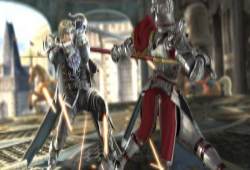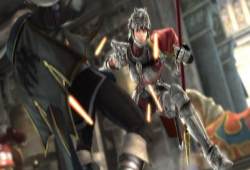| |
 Soul
Calibur IV (Playstation 3) Soul
Calibur IV (Playstation 3)
The epic stage of history is open once again for Namco-Bandai's Soul
Calibur IV, which brings an impressive array of new modes, characters and
features to the fray. An expanded roster of more than 30 characters is
just the beginning, with new character creation and customization modes,
extensive online play, downloadable and extra unlockable content. Soul
Calibur IV's superb production values showcase brilliant character
designs, smooth animation and epic backdrops. With plenty of secrets and
surprises to uncover, this is another outstanding installment in the
long-running Soul Calibur franchise that delivers the excellent gameplay
you've come to expect from the series. |
Even though it doesn't seem to have many revolutionary features on its
surface, Soul Calibur IV is probably the deepest and most robust series on
the console to date. With it's deep set of 30 returning, new and hidden
characters, there's plenty of fighting styles to master, and since each
character can now be customized, there's almost no end to the number of
options available to hardcore players. All of these additions come without
sacrificing the balance, accessibility and entertainment value that this
mainstream fighting series has sought to provide since its beginnings as
Soul Blade more than a decade ago. As you begin, only around half the
characters are available, but more can be unlocked by playing through
various story and arcade modes, and either unlocking them outright or
purchasing them using any acquired points you accumulate. Most players
should be able to unlock most of the regular characters quickly, though
there are a few such as Darth Vader and his Apprentice that require a bit
of skill to defeat. Players will find an array of returning favorites such
as Sophitia, Mitsurigi, Voldo, Taki, Cassandra, Ivy and Yoshimistu along
with new foes plus several guest characters from the Star Wars universe.
These newcomers from LucasArts feel a little bit out of place in the Soul
Calibur universe, but that doesn't mean they aren't fun to play. Who
hasn't dreamed of swinging a light-saber in combat, anyway. It's a bit of
a stretch, but their inclusion feels somewhat less disconnected the more
you play them. The Star Wars characters, aside SCIV still has most of the
familiar style and approach you expect from the series. This broad
selection of characters is surprisingly well balanced and you should find
a relatively evenly matched fight with each battle. Controlling each
character is relatively easy with the standard PS3 controller, with
movement using either the analog stick or d-pad allowing for an easy to
play experience. Adding intuitive button mapping and convenient placement
allows you to get right into the action with little effort. This makes for
a highly enjoyable game, and one that veterans of the previous games
should have little trouble playing. Its accessible controls and simplified
weapons-based combat makes for an immediately appealing title that doesn't
require extensive knowledge of previous titles to enjoy.
 Most
of the previous titles' conventions return here including the standard
8-way running mode, special charge attacks, counters, combos and finishing
moves making for a very familiar feeling game. The basics of SCIV's
weapons-based combat haven't changed that much, which is slightly
disappointing on one level, but still lends this edition a comfortable
feel. One thing that has carried through are the ring outs, which are
annoying and mark a quick, unsatisfying end for too many matches. However,
these aren't really much of an issue once you build up your character
traits and learn to block attacks and power moves. Your opponents can
range from very aggressive to almost docile depending on the difficulty
setting, though those players looking for a challenge will probably want
to play at the higher levels. Still, as stated earlier, the game is
well-balanced and most lost battles are usually the result of your
mistakes, not cheap moves on the part of your opponents. While novice
players might be able to get away with some button mashing in the easier
stages, truly mastering SCIV requires players to learn and deploy a much
deeper skill set, learn the timing and styles of each opposing fighter if
they want to see all that SCIV has to offer. Most
of the previous titles' conventions return here including the standard
8-way running mode, special charge attacks, counters, combos and finishing
moves making for a very familiar feeling game. The basics of SCIV's
weapons-based combat haven't changed that much, which is slightly
disappointing on one level, but still lends this edition a comfortable
feel. One thing that has carried through are the ring outs, which are
annoying and mark a quick, unsatisfying end for too many matches. However,
these aren't really much of an issue once you build up your character
traits and learn to block attacks and power moves. Your opponents can
range from very aggressive to almost docile depending on the difficulty
setting, though those players looking for a challenge will probably want
to play at the higher levels. Still, as stated earlier, the game is
well-balanced and most lost battles are usually the result of your
mistakes, not cheap moves on the part of your opponents. While novice
players might be able to get away with some button mashing in the easier
stages, truly mastering SCIV requires players to learn and deploy a much
deeper skill set, learn the timing and styles of each opposing fighter if
they want to see all that SCIV has to offer.
Previous installments offered plenty of
extra features and Soul Calibur IV is no exception. This installment
offers many of the standard modes players have come to expect plus a whole
lot more. There's a training mode where you can practice your moves, and
improve on your weaknesses. Soul Calibur IV's traditional arcade mode
allows you to battle against a series of foes but this new version now
allows you to check your scores against opponents in ranking charts by
connecting online. SCIV's typically elaborate story mode is impressive, as
each challenge delves into each character's background and story. Playing
through the story mode also allows you to earn gold and points which you
can use to purchase additional characters, weapons and items on the
customization mode. This is another way of keeping players motivated and
adds a sense of purpose to the game, where you're not merely going through
endless battles without an objective. This mode can be quite addictive and
challenging, and the AI of the opponents seems to get harder as you reach
the final boss battles at the end of each character's plot.
Soul Calibur's superb gameplay would be
enough if the features stopped there, but the game also provides a number
of extra in its museum mode including art galleries, character connection
charts, cinematic sequences and much more that players can unlock. One of
the main ways to do this is by earning honors, which are basically
achievements for performing specific tasks or attacks during the various
game modes. This adds more depth to the fighting, and gives players reason
to replay the game. Soul Calibur 4's single player mode is engaging
enough, but the game offers an extensive versus mode where you can compete
against another player either online or with another controller hooked-up.
There are two types of versus modes, Special where your customized weapons
and items can be used to great effect, and Standard, where both players
battle with the regulation characters. These versus modes are complimented
by several other areas of the game that provide plenty of depth. The most
important of these new elements is the character creation mode, which
allows you to design your own unique fighter and use them in various
modes. You have a great deal of flexibility in terms of the characters'
look and can change their hairstyles, outfits, clothing and shoes, along
with facial features, skin tone and many more aesthetic options. However,
the customization is more than skin deep, since you can choose your
characters' fighting style, weapons and special moves list. There are many
items available from the basic customization screen, but players can also
earn and purchase additional items. This is a remarkably flexible system
that's easy to navigate and use, making it easy to create and edit your
characters. SCIV provides enough memory for about 50 customizable
characters, which should be plenty for most players.
 In
addition to the standard battles and arcade modes, Soul Calibur IV
introduces a new mode called Tower of Lost Souls, where you can battle
hordes of enemies in a brutally challenging survival mode. Choosing either
1, 2 or even 3 characters per round, players are pitted against several
other characters, each of which is quite powerful. Making things even more
challenging is the fact that your characters have a single life bar that
is very difficult to replenish. You can switch characters during rounds
and the off-screen ones slowly regain their energy, but you have to battle
strategically in order to move on to the next stage. There are two basic
types of tower mode, Ascending where you have to beat each level of the
tower to claim it, along with bonus character and extra unlockables. If
you choose to go down in descending mode, it becomes a pure test of
endurance to see how many characters you can defeat on a single life-bar.
Towers of Hidden Souls requires players to enter it with a fully
customized and tweaked character. Otherwise, the standard fighters won't
last long against the brutal assaults that await. This mode is easily the
most challenging, and also most satisfying in the game, and truly serves
as a test of your skill and endurance, making it an excellent addition to
the Soul Calibur universe. In
addition to the standard battles and arcade modes, Soul Calibur IV
introduces a new mode called Tower of Lost Souls, where you can battle
hordes of enemies in a brutally challenging survival mode. Choosing either
1, 2 or even 3 characters per round, players are pitted against several
other characters, each of which is quite powerful. Making things even more
challenging is the fact that your characters have a single life bar that
is very difficult to replenish. You can switch characters during rounds
and the off-screen ones slowly regain their energy, but you have to battle
strategically in order to move on to the next stage. There are two basic
types of tower mode, Ascending where you have to beat each level of the
tower to claim it, along with bonus character and extra unlockables. If
you choose to go down in descending mode, it becomes a pure test of
endurance to see how many characters you can defeat on a single life-bar.
Towers of Hidden Souls requires players to enter it with a fully
customized and tweaked character. Otherwise, the standard fighters won't
last long against the brutal assaults that await. This mode is easily the
most challenging, and also most satisfying in the game, and truly serves
as a test of your skill and endurance, making it an excellent addition to
the Soul Calibur universe.
From an aesthetic standpoint, Soul
Calibur IV delivers an excellent looking experience, with cinematic
production values, beautifully rendered backgrounds and an impressive epic
score. As each round begins, the series' bombastic announcer reveals each
character and sets up the drama surrounding each battle. This is
complimented by an epic score, with the typically lush Soul Calibur
soundtrack. The stages range from castles, tranquil fields and rivers to
more ominous stages filled with raging fires and lava. The game's lighting
effects and character renders bring a heightened sense of realism to the
action, with decent voice acting and the sounds of clashing swords adding
to the overall experience. Soul Calibur 4's overall production is slick
and polished, effectively bringing the series to HD consoles in dazzling
form. While the latest edition in the long-running fighting series doesn't
really change the basic gameplay mechanics, it builds on previous
installments with its extensive player customization abilities, several
challenging new modes and newly implemented online play. Soul Calibur IV
features the intuitive controls, deep moves lists and arsenal of weapons
you've come to expect. There are loads of new modes and featues that give
the game plenty of depth while maintaining an excellent sense of balance
and solid play mechanics. Its accessible gameplay, multiple modes of play,
appealing cast of characters and new internet play make this a solid
upgrade for the long-running series and another solid fighting game that
should please fans of the franchise and newcomers alike.
- Michael Palisano
|
| |
|

